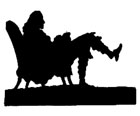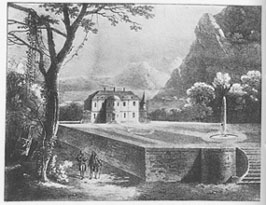

The novel Rasero, by the Mexican writer Francisco Rebolledo, is set in eighteenth-century Europe. Among other famous individuals, the hero of the novel encounters Voltaire whom he visits at Ferney. The following passages are drawn from the first pages of the chapter devoted to his stay there (Francisco Rebolledo, Rasero, trans. Helen R. Lane [Baton Rouge, Louisiana State University Press, 1995], pp. 100-103).
FERNEY, APRIL, 1761
He could see the hand of the philosopher even at the confines of his domains: the inhabitants of Ferney resided in solid stone houses with roofs of fired clay, unlike their neighbors, who lived in miserable hovels made of wood and mud. Every house, moreover, had a well-cultivated and well-stocked garden, and almost all of them a little stable that sheltered a couple of milch cows. Many of them had glass panes in their windows--a real luxury in the countryside--and their sills adorned with pots full of bright-colored flowers. An abundance of hens, ducks, and geese happily roamed about the houses, pecking at the ground in search of food.
[. . . .]
The smiling faces of the peasants, robust, red cheeked, well dressed, who hailed the carriage as it passed by, confirmed the prosperity of their master. For Voltaire, once he had taken up residence he Ferney, used his wealth intelligently, doing his best to see that his workers and his neighbors earned enough to lead a worthy and tranquil life. In a very short time he managed to realize an old dream: creating a tiny republic ruled by reason and tolerance, the old utopia of the wise, paternal, and benevolent governor who ensures the welfare of his subjects. He was finally able to create at Ferney that just and enlightened government he had so strongly urged upon monarchs in his works and upon Frederick by speaking directly into his ear. He taught :he peasants to improve their techniques of cultivation and secured posts for their sons, instructing them in the difficult art of watch-making that his Geneva neighbors were so adept at. Paradoxically, he fortified the religious beliefs of his villagers, for he was convinced that the principles of Catholicism have a wholesome influence on humble people. He gave out work and wealth, trying to involve everyone in the common good. Inspired perhaps by the Jesuit republic of Paraguay, which he so greatly admired, he tried to make of Ferney a splendid showpiece of what a human community is capable of achieving if it is governed wisely and beneficently.
The berlin finally reached the heart of the town, where the philosopher's residence was located. It was an imposing square construction, three stories high. The building, recently restored, had been redone in the purest neoclassic style. The walls, now perfectly smooth, were painted cream color. The trim around the windows and the two little doors that opened at either end of each one of them were painted a luminous green. The imaginary lines that joined the windows and the main door headed, in an impeccable straight line, toward a distant vanishing point. The whole was harmonious and symmetrical; it gave the sensation that if each end of the building were placed in the weighing pans of an enormous balance scale, they would not deviate from their position of equilibrium by the least fraction. A gentle semicircular projection in the center of the west wing of the building broke the regularity of the design. Opposite this facade rose a singular garden, in the literal sense of the word rose, for the garden was on an esplanade two paces high. The esplanade was rectangular and was more than two hundred paces long; it ended in a semicircle that formed a counterpart to the one on the facade and enclosed a little circular fountain adorned with a graceful obelisk in the center. One could stroll through the garden on flagstone walkways, bordered with perfectly pruned hedges. The garden was no doubt inspired by the one Le Notre had designed at Versailles, which was to win immortality. This one, of course, was much smaller, though more harmonious and more elegant as well.
